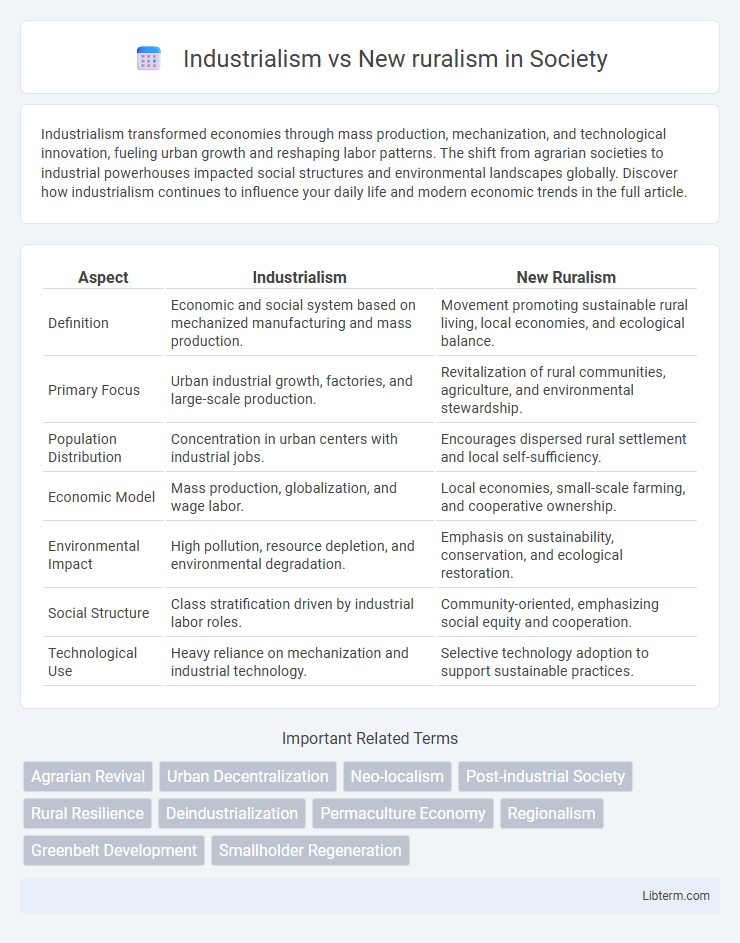Industrialism transformed economies through mass production, mechanization, and technological innovation, fueling urban growth and reshaping labor patterns. The shift from agrarian societies to industrial powerhouses impacted social structures and environmental landscapes globally. Discover how industrialism continues to influence your daily life and modern economic trends in the full article.
Table of Comparison
| Aspect | Industrialism | New Ruralism |
|---|---|---|
| Definition | Economic and social system based on mechanized manufacturing and mass production. | Movement promoting sustainable rural living, local economies, and ecological balance. |
| Primary Focus | Urban industrial growth, factories, and large-scale production. | Revitalization of rural communities, agriculture, and environmental stewardship. |
| Population Distribution | Concentration in urban centers with industrial jobs. | Encourages dispersed rural settlement and local self-sufficiency. |
| Economic Model | Mass production, globalization, and wage labor. | Local economies, small-scale farming, and cooperative ownership. |
| Environmental Impact | High pollution, resource depletion, and environmental degradation. | Emphasis on sustainability, conservation, and ecological restoration. |
| Social Structure | Class stratification driven by industrial labor roles. | Community-oriented, emphasizing social equity and cooperation. |
| Technological Use | Heavy reliance on mechanization and industrial technology. | Selective technology adoption to support sustainable practices. |
Understanding Industrialism: Definition and Principles
Industrialism is an economic and social system centered on large-scale manufacturing, mechanization, and technological innovation that drives mass production and urbanization. Its principles emphasize efficiency, specialization of labor, and the exploitation of natural resources to fuel industrial growth and economic expansion. This system reshaped societies by shifting populations from agrarian lifestyles to factory-based economies, fostering infrastructure development and technological progress.
The Rise of New Ruralism: Origins and Core Concepts
The rise of New Ruralism stems from a reaction against the environmental and social consequences of industrialism, emphasizing sustainable agriculture, local economies, and community resilience. Originating in the late 20th century, New Ruralism integrates ecological stewardship with cultural preservation, promoting decentralized systems and reducing dependency on urban industrial centers. Core concepts include agroecology, renewable energy adoption, and the revitalization of rural spaces to foster economic independence and environmental sustainability.
Key Differences Between Industrialism and New Ruralism
Industrialism emphasizes mass production, urbanization, and mechanization, driving economic growth through factory-based industries. New Ruralism prioritizes sustainability, local agriculture, and community-centric living, aiming to revive rural economies and preserve environmental resources. The core difference lies in Industrialism's focus on efficiency and scale versus New Ruralism's emphasis on ecological balance and localized development.
Economic Impacts: Urban Industry vs Rural Revitalization
Industrialism drives urban economic growth through mass production, creating jobs in manufacturing and infrastructure development that boost city economies. New ruralism revitalizes rural areas by promoting local agriculture, eco-tourism, and small-scale businesses, fostering sustainable economic diversification. The shift from industrial centers to rural economic models emphasizes resilience, community investment, and environmental stewardship to balance regional development.
Environmental Implications of Both Approaches
Industrialism drives large-scale manufacturing and urban expansion, leading to significant carbon emissions, habitat destruction, and resource depletion. New ruralism emphasizes sustainable agriculture, local ecosystems preservation, and reduced reliance on fossil fuels, promoting biodiversity and soil health. The environmental implications highlight a contrast between Industrialism's ecological footprint and New ruralism's focus on conservation and regenerative practices.
Technological Innovation in Industrialism and New Ruralism
Industrialism thrives on rapid technological innovation, emphasizing mechanization, automation, and mass production to enhance efficiency and economic growth. New Ruralism integrates technology selectively, prioritizing sustainable and eco-friendly tools such as renewable energy systems, precision agriculture, and smart farming to support local ecosystems and community resilience. These contrasting approaches reflect Industrialism's focus on large-scale industrial machinery versus New Ruralism's adoption of innovative, low-impact technologies tailored to rural development.
Social and Cultural Shifts: City Life vs Rural Communities
Industrialism accelerated urbanization, transforming city life into bustling centers of economic opportunity, diverse social interactions, and cultural dynamism. In contrast, New Ruralism emphasizes revitalizing rural communities by fostering local traditions, close-knit social bonds, and sustainable cultural practices rooted in agricultural heritage. This social and cultural shift highlights the tension between industrial urban expansion and the preservation of rural identities and community cohesion.
Case Studies: Success Stories and Challenges
Case studies of industrialism reveal significant economic growth and urban expansion in cities like Detroit and Manchester, driven by manufacturing and technological innovation, but also highlight challenges such as environmental degradation and labor exploitation. In contrast, new ruralism case studies from regions like Vermont and the Scottish Highlands showcase successful community-driven sustainability initiatives, emphasizing local agriculture and eco-tourism while facing obstacles like limited infrastructure and population decline. Both paradigms demonstrate the complex balance between economic development and social-environmental sustainability.
Future Trends: Reconciling Industrial and Rural Models
Future trends in reconciling industrialism and new ruralism emphasize sustainable development integrating advanced manufacturing technologies with eco-friendly agricultural practices. Smart rural infrastructures leveraging IoT, renewable energy, and automation promote economic diversification while preserving rural ecosystems. Collaborative policy frameworks and community-driven initiatives are driving balanced growth by bridging the efficiency of industrial models with the resilience of rural traditions.
Choosing a Sustainable Path: Policy and Personal Decisions
Industrialism emphasizes mass production and urban expansion, often leading to significant environmental degradation and resource depletion. New ruralism advocates for sustainable agriculture, local economies, and ecological balance, promoting policies that support renewable practices and community resilience. Policy frameworks prioritizing green infrastructure and personal decisions favoring reduced consumption and support for local food systems are crucial for achieving a sustainable future.
Industrialism Infographic

 libterm.com
libterm.com